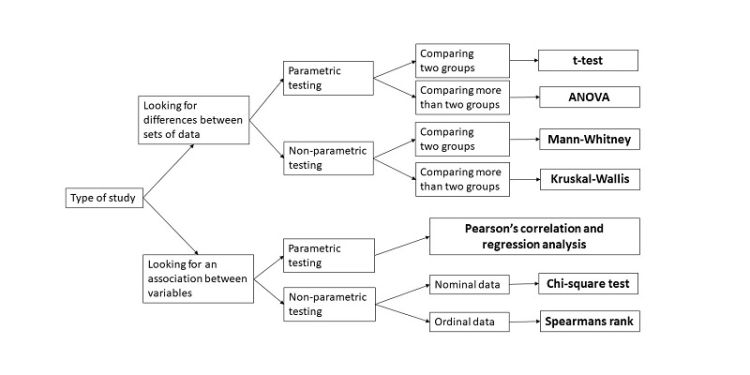Statistical tests
Find a test
Our quick guide to selecting the right statistical test for your type of study is below.
Another useful tool to identify the most appropriate statistical test for your data is the Which Stats Test developed by Sage Research Methods. This asks a series of questions to determine which test is best. You’ll need to understand some basic statistical terms to access and use this tool, which is useful for students at all levels.
Tests can be split into two categories:
- difference tests (exploring differences between sets of data)
- association tests (identifying an association between sets of data).
We have linked to more detailed information on the Statstutor site, which provides a variety of useful resources on how to conduct common statistical tests.

Decision tree diagram for choosing a statistical test
Difference tests
As a general rule of thumb, where the explanatory variable is nominal, you should choose a difference test.
Parametric testing
For exploring differences between sets of numerical data: if you want to compare two groups, use a t-test; if you want to compare more than two groups, use the ANOVA test.
Statstutor resources:
Non-parametric testing
For exploring differences between sets of categorical data: if you want to compare two groups, use the Mann-Whitney test; if you want to compare more than two groups, use the Kruskal-Wallis test.
Statstutor resources:
Association tests
Parametric testing
For identifying an association between different sets of numerical data, use Pearson’s correlation and regression analysis.
Statstutor resources:
Non-parametric testing
For identifying an association between different sets of categorical data: if you have nominal data, use the chi-square test; if you have ordinal data, use the Spearmans rank test.
Statstutor resources:
Further information
For more detailed information and instruction about different types of test, see the Sage Research Methods Which Stats Test
If your work requires application of more advanced statistical methods, have a look on the Sage Research Methods website for SAGE’s popular Quantitative Applications in the Social Sciences series. This provides short and accessible texts (called Little Green Books) on all kinds of quantitative methods, such as fixed effects regression models, multivariate general linear models and time-series analysis. You will need to login via the institutional login page using your University of Leeds details.
Further help
If you have more questions, please ask us online, or book a one-to-one appointment with a statistics advisor, or sign up for one of our statistics workshops.

